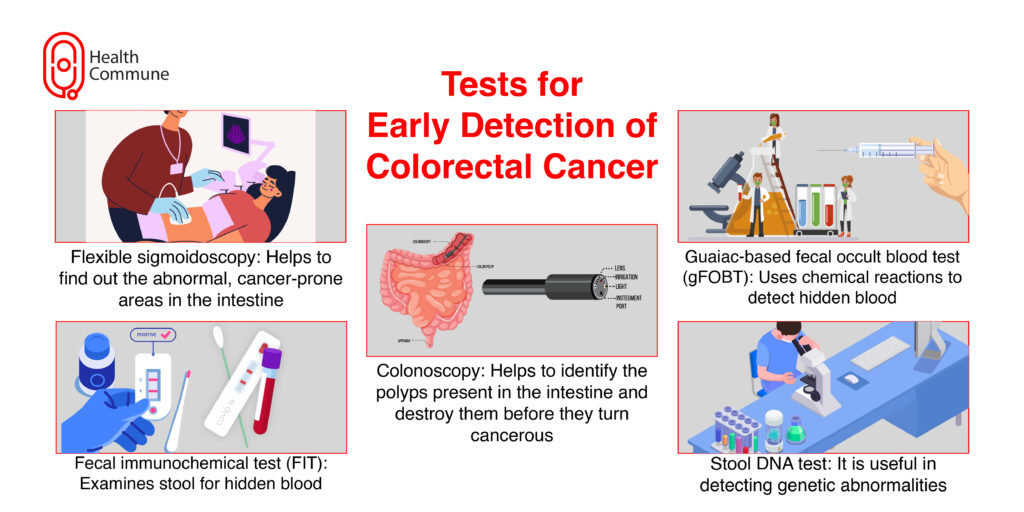The goal of cancer screening is to identify symptomatic individuals at the earliest stage so that their treatment outcomes are optimised. Delayed treatment leads to reduced chances of survival, greater side effects, and higher costs. This article explains the early detection tests available for the top 10 cancers found in India.
Breast cancer
- Mammograms can assist in detecting breast cancer early on when therapy has the best chance of being effective. They frequently detect breast abnormalities years before the symptoms appear
- A self-breast exam is useful in identifying lumps in the breasts and surrounding region, which leads to the early detection of cancer
- Blood test for tumour markers detects circulating tumour cells and tumour antigens even before the appearance of symptoms and can diagnose breast cancer with over 90% sensitivity and specificity
- BRCA gene testing uses a sample of your blood, saliva, or cheek cells to identify genetic mutations associated with breast cancer. While a negative test result can be reassuring, a positive test result can assist in predicting genetic susceptibility thus leading to vigilance, early detection, management, and targeted therapy
- Other genetic tests include multi-gene panel testing, germline genetic testing, TP53 testing, CHEK2 gene testing, etc.
Lung cancer
- Low-dose CT (low-dose spiral CT scan or helical CT scan) is useful for screening and detection of lung cancer in high-risk patients
Stomach cancer
- Upper gastrointestinal endoscopy is the most dependable and accurate test for gastrointestinal diseases, particularly those affecting the stomach’s and small intestine’s inner lining
- Endoscopic ultrasounds are particularly helpful for viewing the middle and outer layers of the gut, which help your doctor in determine the size and extent of the tumour’s spread

Oral cancer
Oral cancer usually presents as a patch, lump or ulcer in the mouth. The following tests are done on a person with any of these symptoms:
- Physical assessment the head, neck, oral, and pharyngeal regions will be visually inspected and palpated by the doctor. The physical assessment involves the following:
a. Digital palpation of neck node areas
b. Bimanual palpation of the tongue and floor of the mouth
c. Examination of the oral and pharyngeal mucosa under a suitable light source with mouth mirrors is crucial to the examination.
- Special dyes such as toluidine blue and Lugol’s iodine are used for identifying areas with abnormal changes (dysplasia). The dye stains the abnormal areas differently, which differentiates them from normal areas.
- Exfoliative cytology is a technique in which a harsh brush is used to scrape off cells from an abnormal or suspicious area in the mouth. In a lab, these cells are examined under the microscope to see if there are cancerous changes in them.
Liver cancer
- Alpha-fetoprotein (AFP) tumour marker test: Organs, tissues, or tumour cells in the body release tumour markers into the blood. A higher amount of AFP in the blood could indicate liver cancer in the early stages
- An ultrasound scan is a type of high-energy sound wave that creates echoes when it strikes the liver and can be used for the early detection of liver cancer, especially in those who are at high risk
Colorectal cancer
- Faecal immunochemical test (FIT) examines the stool for any traces of hidden blood. This is recommended annually
- Guaiac-based fecal occult blood test (gFOBT) This test is similar to FIT but uses a chemical reaction to detect occult (hidden) blood in the stool, which can be used as an early indicator of cancer
- Stool DNA test is useful in detecting genetic abnormalities. Cells with polyps or colorectal cancer frequently have DNA mutations (changes) in certain genes. These mutant cells frequently enter the stool and can be detected very early by this test
- Colonoscopy helps to identify the polyps present in the intestine and destroy them before they turn cancerous
- Flexible sigmoidoscopy helps to find out the abnormal, cancer-prone areas in the intestine
Cervical cancer
- Pap smear test can identify abnormal cervical cells and cells that have undergone alterations that increase cervical cancer risk
- HPV-DNA test detects the presence of high-risk strains of the human papillomavirus ( HPV) that are most likely to cause cervical cancer
- Visual assessment using acetic acid (VIA) helps to examine abnormal areas in the cervix. They turn white when exposed to acetic acid. In areas with restricted access to medical care, this screening test is quite helpful
Prostate cancer
- Digital rectal exam notices any irregularities in the texture, shape, or size of the gland, which can be an early marker of cancer
- Prostate-specific antigen (PSA) test is the gold standard for screening prostate cancer. It detects the amount of PSA present in the blood. Higher than usual levels indicate prostate infection, inflammation, enlargement, or cancer
- Prostate cancer urine test detects the presence of PSA-3 in your urine. It is useful in determining if a prostate biopsy is required
Pancreatic cancer
- Genetic testing looks for genetic alterations and is especially useful for people with a positive family history of pancreatic cancer, eg., ATM, BRCA 1, BRCA 2, TP53 etc. Genetic tests help identify people who have a susceptibility to developing pancreatic cancer
- Endoscopic ultrasound is useful for those with a family history of cancer or high-risk individuals
Blood cancer (Leukaemia)
- Blood test and peripheral smear are among the initial screening tests for leukaemia. If your red blood cells, white blood cells, or platelets are abnormally high or low, or if the structure of your cells is abnormal, it could indicate leukaemia
- Flow cytometry helps identify ‘tumour markers’ on the surface of cells. They can be useful for the diagnosis and staging of cancer





